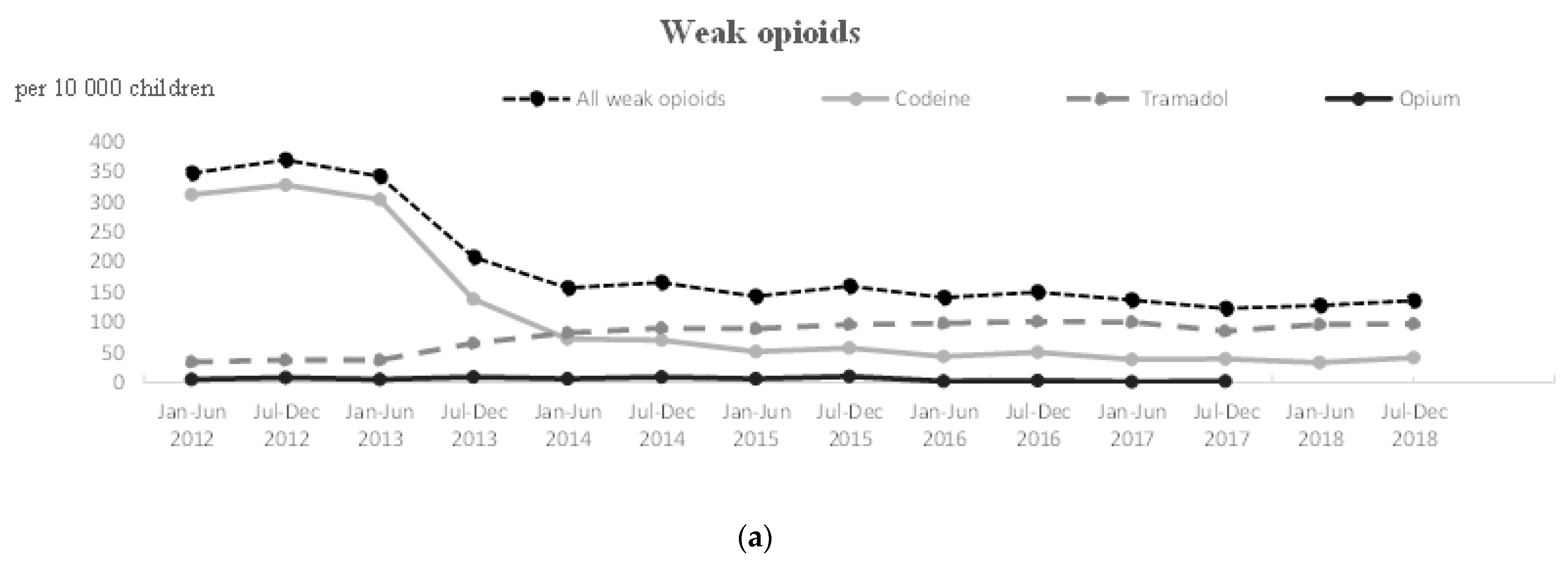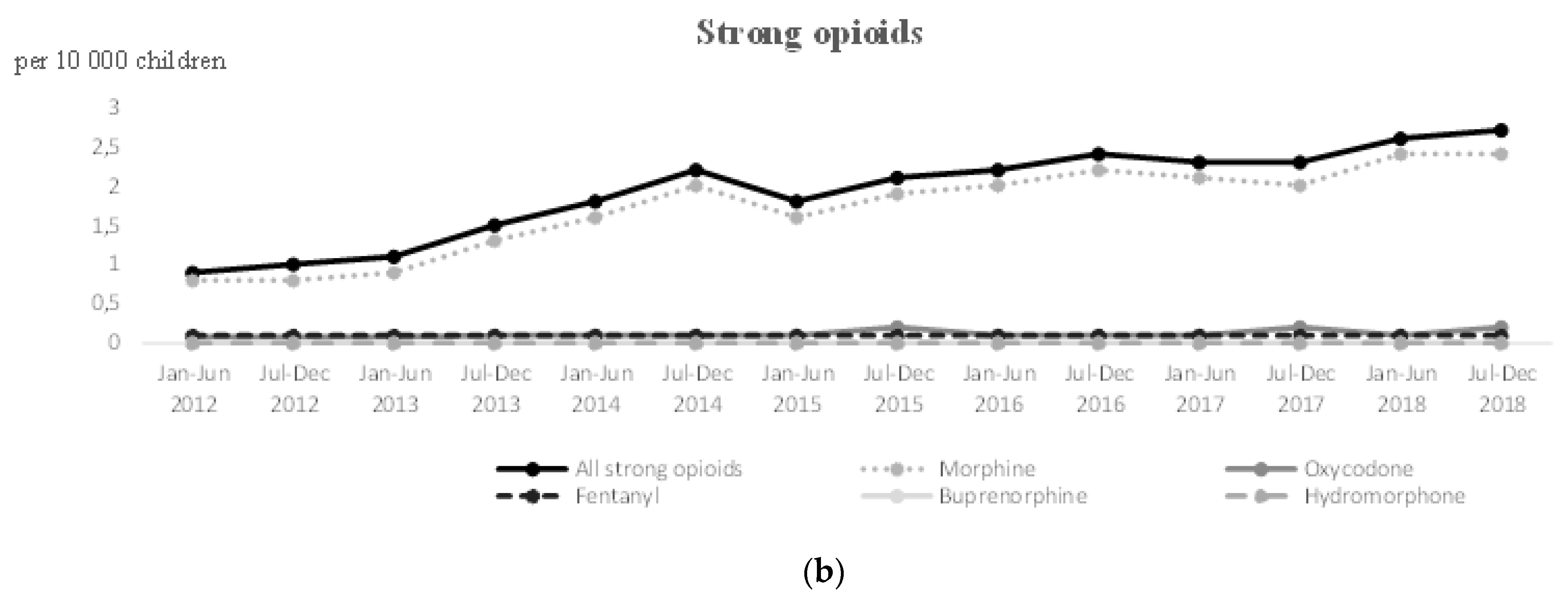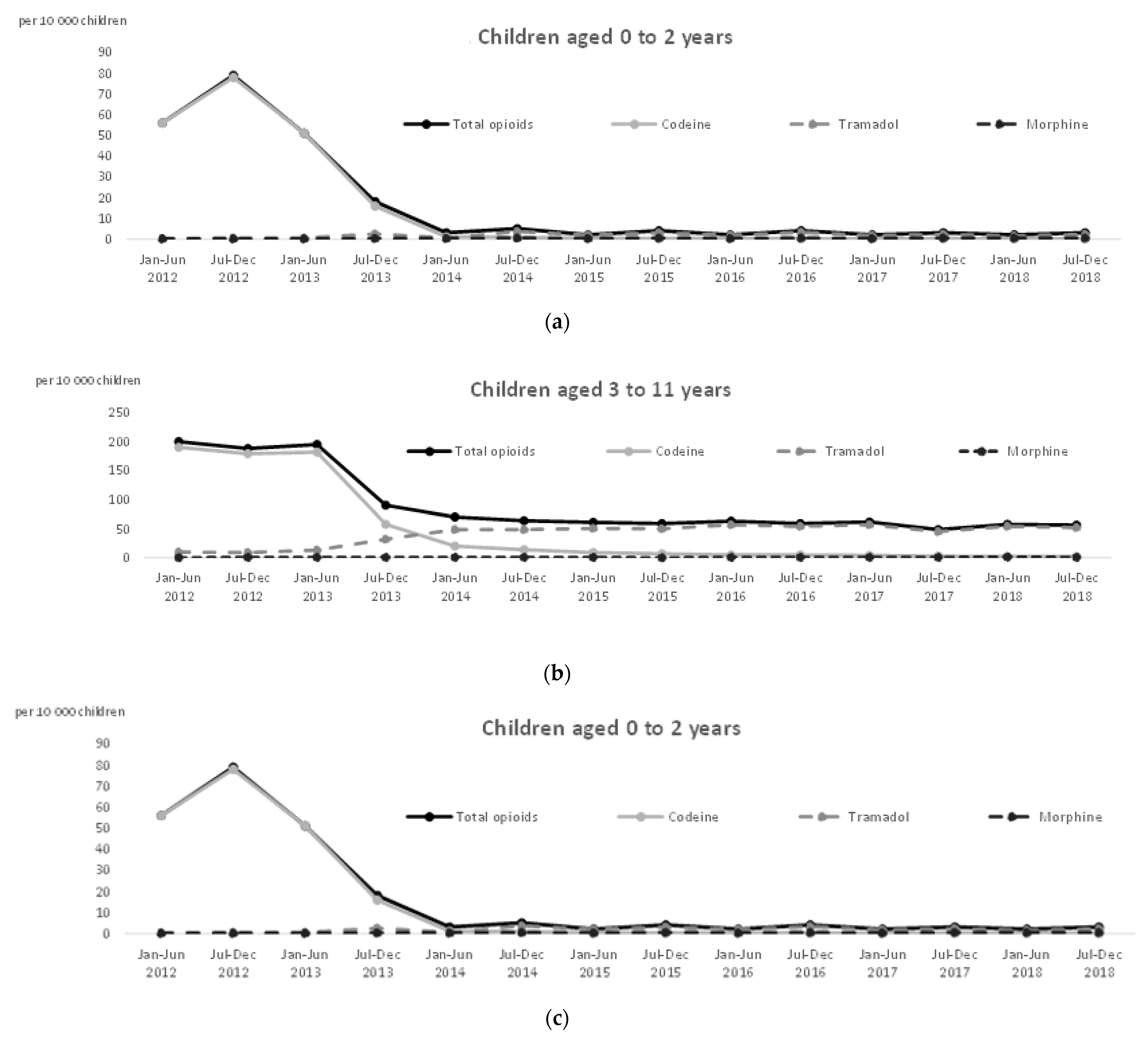Opioid Analgesic Prescription in French Children: A National Population-Based Study
Abstract
1. Introduction
2. Materials and Methods
2.1. Participants
2.2. Study Design
2.3. Data
2.4. Analyses
2.5. Ethics
3. Results
4. Discussion
5. Conclusions
Author Contributions
Funding
Institutional Review Board Statement
Informed Consent Statement
Data Availability Statement
Conflicts of Interest
References
- Chenaf, C.; Kaboré, J.-L.; Delorme, J.; Pereira, B.; Mulliez, A.; Zenut, M.; Delage, N.; Ardid, D.; Eschalier, A.; Authier, N. Prescription Opioid Analgesic Use in France: Trends and Impact on Morbidity–Mortality. Eur. J. Pain 2019, 23, 124–134. [Google Scholar] [CrossRef] [PubMed]
- Mahic, M.; Fredheim, O.M.; Borchgrevink, P.C.; Skurtveit, S. Use of Prescribed Opioids by Children and Adolescents: Differences between Denmark, Norway and Sweden. Eur. J. Pain 2015, 19, 1095–1100. [Google Scholar] [CrossRef]
- Tomaszewski, D.M.; Arbuckle, C.; Yang, S.; Linstead, E. Trends in Opioid Use in Pediatric Patients in US Emergency Departments From 2006 to 2015. JAMA Netw. Open 2018, 1, e186161. [Google Scholar] [CrossRef] [PubMed]
- Bell, J.; Paget, S.P.; Nielsen, T.C.; Buckley, N.A.; Collins, J.; Pearson, S.-A.; Nassar, N. Prescription Opioid Dispensing in Australian Children and Adolescents: A National Population-Based Study. Lancet Child Adolesc. Health 2019, 3, 881–888. [Google Scholar] [CrossRef]
- European Medicines Agency. Codeine Containing Medicinal Products for the Treatment of Cough and/or Cold in Paediatric Patients. 2015. Available online: https://www.ema.europa.eu/en/documents/referral/codeine-article-31-referral-prac-assessment-report_en-0.pdf (accessed on 12 March 2015).
- US Food and Drug Administration FDA Drug Safety Administration: Safety Review Update of Codeine Use in Children; New Boxed Warning and Contraindication on Use after Tonsillectomy and/or Adenoidectomy. 2013. Available online: https://www.fda.gov/media/85072/download (accessed on 20 February 2013).
- ANSM. Médicaments à Base de Tétrazépam, D’almitrine, de Ranélate de Strontium et de Codéine (Chez L’enfant): Avis et Recommandations du PRAC—Communiqué de l’EMA. avril 2013, 4. Available online: http://www.pharmacovigilance-limoges.fr/sites/default/files/files/Recommandations/Medicamentsbase%20de%20tetrazepam12042013.pdf (accessed on 1 April 2013).
- US Food and Drug Administration FDA Drug Safety Communication: FDA Restricts Use of Prescription Codeine Pain and Cough Medicines and Tramadol Pain Medicines in Children; Recommends against Use in Breastfeeding Women. Available online: https://www.fda.gov/drugs/drug-safety-and-availability/fda-drug-safety-communication-fda-restricts-use-prescription-codeine-pain-and-cough-medicines-and (accessed on 20 April 2017).
- HAS. Prise en Charge Médicamenteuse de la Douleur Chez L’enfant: Alternatives à la Codéine. 2016. Available online: https://www.has-sante.fr/upload/docs/application/pdf/2016-02/prise_en_charge_medicamenteuse_de_la_douleur_chez_lenfant_alternatives_a_la_codeine_-_fiche_memo.pdf (accessed on 1 January 2016).
- Bezin, J.; Duong, M.; Lassalle, R.; Droz, C.; Pariente, A.; Blin, P.; Moore, N. The National Healthcare System Claims Databases in France, SNIIRAM and EGB: Powerful Tools for Pharmacoepidemiology. Pharmacoepidemiol. Drug Saf. 2017, 26, 954–962. [Google Scholar] [CrossRef] [PubMed]
- Groenewald, C.B.; Rabbitts, J.A.; Gebert, J.T.; Palermo, T.M. Trends in Opioid Prescriptions among Children and Adolescents in the United States: A Nationally Representative Study from 1996 to 2012. Pain 2016, 157, 1021–1027. [Google Scholar] [CrossRef]
- George, J.A.; Park, P.S.; Hunsberger, J.; Shay, J.E.; Lehmann, C.U.; White, E.D.; Lee, B.H.; Yaster, M. An Analysis of 34,218 Pediatric Outpatient Controlled Substance Prescriptions. Anesthesia Analg. 2016, 122, 807–813. [Google Scholar] [CrossRef]
- Taine, M.; Offredo, L.; Dray-Spira, R.; Weill, A.; Chalumeau, M.; Zureik, M. Paediatric Outpatient Prescriptions in France between 2010 and 2019: A Nationwide Population-Based Study: Paediatric Outpatient Prescriptions in France, 2010 to 2019. Lancet Reg. Health Eur. 2021, 7, 100129. [Google Scholar] [CrossRef] [PubMed]
- Rosman, S.; Le Vaillant, M.; Schellevis, F.; Clerc, P.; Verheij, R.; Pelletier-Fleury, N. Prescribing Patterns for Upper Respiratory Tract Infections in General Practice in France and in the Netherlands. Eur. J. Public Health 2008, 18, 312–316. [Google Scholar] [CrossRef][Green Version]
- Country Profiles International Health Care System Profiles. Available online: https://www.commonwealthfund.org/international-health-policy-center/countries (accessed on 29 October 2021).
- Hedenmalm, K.; Blake, K.; Donegan, K.; Macia, M.-A.; Gil, M.; Williams, J.; Montero, D.; Candore, G.; Morales, D.; Kurz, X.; et al. A European Multicentre Drug Utilisation Study of the Impact of Regulatory Measures on Prescribing of Codeine for Pain in Children. Pharmacoepidemiol. Drug Saf. 2019, 28, 1086–1096. [Google Scholar] [CrossRef]
- Cheng, J.; Sobol, S. Despite Warnings, Some Graduating Otolaryngology Residents Planning to Use Codeine for Posttonsillectomy Pain Control. Otolaryngol. Head Neck Surg. 2013, 148, 356–357. [Google Scholar] [CrossRef]
- de Suremain, N.; Guedj, R.; Fratta, A.; Franclin, A.; Loschi, S.; Aroulandom, J.; Carbajal, R. Acute Gingivostomatitis in Children: Epidemiology in the Emergency Department, Pain, and Use of Codeine before Its Restriction. Arch. Pediatr. 2019, 26, 80–85. [Google Scholar] [CrossRef]
- TANNE, C.; Javouhey, E.; Millet, A.; Bordet, F. Severe Tramadol Overdoses in Children: A Case Series Admitted to Paediatric Intensive Care Unit. J. Clin. Toxicol. 2016, 6, 1000317. [Google Scholar] [CrossRef]
- Orliaguet, G.; Hamza, J.; Couloigner, V.; Denoyelle, F.; Loriot, M.-A.; Broly, F.; Garabedian, E.N. A Case of Respiratory Depression in a Child with Ultrarapid CYP2D6 Metabolism after Tramadol. Pediatrics 2015, 135, e753–e755. [Google Scholar] [CrossRef] [PubMed]
- Rodieux, F.; Vutskits, L.; Posfay-Barbe, K.M.; Habre, W.; Piguet, V.; Desmeules, J.A.; Samer, C.F. When the Safe Alternative Is Not That Safe: Tramadol Prescribing in Children. Front. Pharmacol. 2018, 9, 148. [Google Scholar] [CrossRef]
- Wei Chern Gan, R.; Kamani, T.; Daniel, M. Place de l’Oramorph En Complément de l’ibuprofène et Du Paracétamol Dans La Prise En Charge de La Douleur Après Adéno-Amygdalectomie Chez l’enfant. Ann. Françaises d’Oto-rhino-Laryngol. Pathol. Cervico-Faciale 2017, 134, 23–25. [Google Scholar] [CrossRef]
- Wong, C.; Lau, E.; Palozzi, L.; Campbell, F. Pain Management in Children: Part 2—A Transition from Codeine to Morphine for Moderate to Severe Pain in Children. Can. Pharm. J. 2012, 145, 276–279.e1. [Google Scholar] [CrossRef] [PubMed]
- Van Hulle Vincent, C.; Gaddy, E.J. Pediatric Nurses’ Thinking in Response to Vignettes on Administering Analgesics. Res. Nurs. Health 2009, 32, 530–539. [Google Scholar] [CrossRef] [PubMed]
- Yang, Y.T.; Chen, B.; Bennett, C.L. FDA Approval of Extended-Release Oxycodone for Children With Severe Pain. Pediatrics 2016, 137, e20160205. [Google Scholar] [CrossRef]
- Samer, C.F.; Daali, Y.; Wagner, M.; Hopfgartner, G.; Eap, C.B.; Rebsamen, M.C.; Rossier, M.F.; Hochstrasser, D.; Dayer, P.; Desmeules, J.A. The Effects of CYP2D6 and CYP3A Activities on the Pharmacokinetics of Immediate Release Oxycodone. Br. J. Pharmacol. 2010, 160, 907–918. [Google Scholar] [CrossRef]
- Balyan, R.; Mecoli, M.; Venkatasubramanian, R.; Chidambaran, V.; Kamos, N.; Clay, S.; Moore, D.L.; Mavi, J.; Glover, C.D.; Szmuk, P.; et al. CYP2D6 Pharmacogenetic and Oxycodone Pharmacokinetic Association Study in Pediatric Surgical Patients. Pharmacogenomics 2017, 18, 337–348. [Google Scholar] [CrossRef] [PubMed]
- Koller, D.M.; Myers, A.B.; Lorenz, D.; Godambe, S.A. Effectiveness of Oxycodone, Ibuprofen, or the Combination in the Initial Management of Orthopedic Injury-Related Pain in Children. Pediatr. Emerg. Care 2007, 23, 627–633. [Google Scholar] [CrossRef] [PubMed]
- Ali, S.; Manaloor, R.; Johnson, D.W.; Rosychuk, R.J.; LeMay, S.; Carleton, B.; McGrath, P.J.; Drendel, A.L.; Pediatric Emergency Research Canada. An Observational Cohort Study Comparing Ibuprofen and Oxycodone in Children with Fractures. PLoS ONE 2021, 16, e0257021. [Google Scholar] [CrossRef]
- Katz, D.A.; Hays, L.R. Adolescent OxyContin Abuse. J. Am. Acad. Child. Adolesc. Psychiatry 2004, 43, 231–234. [Google Scholar] [CrossRef] [PubMed]
- Renny, M.H.; Yin, H.S.; Jent, V.; Hadland, S.E.; Cerdá, M. Temporal Trends in Opioid Prescribing Practices in Children, Adolescents, and Younger Adults in the US From 2006 to 2018. JAMA Pediatr. 2021, 175, 1043–1052. [Google Scholar] [CrossRef]
- Groenewald, C.B.; Rabbitts, J.A.; Schroeder, D.R.; Harrison, T.E. Prevalence of Moderate-Severe Pain in Hospitalized Children. Paediatr. Anaesth. 2012, 22, 661–668. [Google Scholar] [CrossRef]
- Alexander, J.; Manno, M. Underuse of Analgesia in Very Young Pediatric Patients with Isolated Painful Injuries. Ann. Emerg. Med. 2003, 41, 617–622. [Google Scholar] [CrossRef]
- Bawa, M.; Mahajan, J.K.; Aggerwal, N.; Sundaram, J.; Rao, K.L.N. Barriers to Pediatric Pain Management in Children Undergoing Surgery: A Survey of Health Care Providers. J. Pain Palliat. Care Pharm. 2015, 29, 353–358. [Google Scholar] [CrossRef] [PubMed]
- de Freitas, G.R.M.; de Castro, C.G.; Castro, S.M.J.; Heineck, I. Degree of Knowledge of Health Care Professionals about Pain Management and Use of Opioids in Pediatrics. Pain Med. 2014, 15, 807–819. [Google Scholar] [CrossRef]
- Miech, R.; Johnston, L.; O’Malley, P.M.; Keyes, K.M.; Heard, K. Prescription Opioids in Adolescence and Future Opioid Misuse. Pediatrics 2015, 136, e1169–e1177. [Google Scholar] [CrossRef] [PubMed]
- Cortellazzo Wiel, L.; Poropat, F.; Barbi, E.; Cozzi, G. Is Opioid Analgesia Superior to NSAID Analgesia in Children with Musculoskeletal Trauma? Arch. Dis. Child. 2020, 105, 1229–1232. [Google Scholar] [CrossRef] [PubMed]
- Drendel, A.L.; Gorelick, M.H.; Weisman, S.J.; Lyon, R.; Brousseau, D.C.; Kim, M.K. A Randomized Clinical Trial of Ibuprofen versus Acetaminophen with Codeine for Acute Pediatric Arm Fracture Pain. Ann. Emerg. Med. 2009, 54, 553–560. [Google Scholar] [CrossRef] [PubMed]
- Kelley-Quon, L.I.; Kirkpatrick, M.G.; Ricca, R.L.; Baird, R.; Harbaugh, C.M.; Brady, A.; Garrett, P.; Wills, H.; Argo, J.; Diefenbach, K.A.; et al. Guidelines for Opioid Prescribing in Children and Adolescents After Surgery: An Expert Panel Opinion. JAMA Surg. 2021, 156, 76–90. [Google Scholar] [CrossRef]
- Horton, J.D.; Munawar, S.; Feuvrier, A.; Corrigan, C.; Lockett, M.; White, D.; Cina, R.A. Specialty-Specific Reduction in Opioid Prescribing after Common Pediatric Surgical Operations. J. Pediatr. Surg. 2019, 54, 1984–1987. [Google Scholar] [CrossRef] [PubMed]
- Trends in Analgesic Consumption in France over the Last 10 Years and Comparison of Patterns across Europe—Hider-Mlynarz —2018—British Journal of Clinical Pharmacology—Wiley Online Library. Available online: https://bpspubs.onlinelibrary.wiley.com/doi/full/10.1111/bcp.13564 (accessed on 29 October 2021).



| 2012 (n) | per 10,000 | 2018 (n) | per 10,000 | p-Value | Variation between 2012 and 2018 (%) | |
|---|---|---|---|---|---|---|
| Children who received at least one opioid dispensation | 452,665 | 347.5 | 169,338 | 130.2 | <0.0001 | −62.5 |
| Mean age (±sd) | 7.3 ± 4.8 | 10.7 ± 4.2 | ||||
| Age distribution | ||||||
| [0–2] | 85,469 | 65.6 | 3554 | 2.7 | <0.0001 | −95.9 |
| [3–5] | 126,348 | 97.0 | 26,092 | 20.0 | −79.4 | |
| [6–11] | 118,714 | 91.1 | 46,614 | 35.8 | −60.7 | |
| [12–15] | 122,134 | 93.7 | 93,078 | 71.6 | −23.6 | |
| Sex | ||||||
| Female | 209,903 | 161.1 | 85,585 | 65.8 | <0.0001 | −59.2 |
| Male | 242,762 | 186.4 | 83,753 | 64.4 | −65.5 | |
| Weak opioids | 449,068 | 344.8 | 166,773 | 128.2 | <0.0001 | −62.8 |
| Codeine | 401,872 | 308.5 | 47,295 | 36.3 | <0.0001 | −88.2 |
| Dihydrocodéine | 47 | 0.0 | 39 | 0.0 | 0.0002 | −17 |
| Codeine off-label prescription | - | - | 4143 | 3.1 | ||
| Tramadol | 45,313 | 34.7 | 123,046 | 94.6 | <0.0001 | +171.5 |
| Tramadol off-label prescription | 649 | 2417 | 1.8 | +272 | ||
| Opium | 9058 | 6.9 | - | - | - | |
| Strong opioids | 1226 | 0.9 | 3359 | 2.6 | <0.0001 | +173.9 |
| Morphine | 1041 | 0.7 | 3032 | 2.3 | <0.0001 | +191.2 |
| Fentanyl | 157 | 0.1 | 188 | 0.1 | <0.0001 | +19.7 |
| Buprenorphine | 9 | 0.0 | 2 | 0.0 | 0.50 | +77.7 |
| Hydromorphone | 2 | 0.0 | 5 | 0.0 | 0.009 | +150 |
| Oxycodone | 112 | 0.0 | 279 | 0.2 | <0.0001 | +149.1 |
| Mode of exercice | ||||||
| Private practice | 257,734 | 197.9 | 80,236 | 61.7 | <0.0001 | −68.8 |
| Hospital | 170,035 | 130.5 | 75,648 | 58.1 | <0.0001 | −55.5 |
| Speciality | ||||||
| General Medicine | 313,827 | 240.9 | 95,464 | 73.4 | <0.0001 | −69.5 |
| Pediatrics | 45,938 | 35.2 | 10,601 | 8.1 | <0.0001 | −76.9 |
| Surgical specialties | 44,080 | 33.8 | 25,147 | 19.3 | <0.0001 | −42.9 |
| Chronic illness | 11,909 | 9.1 | 4455 | 3.4 | <0.01 | −62.5 |
| January–June 2012 | July–December 2012 | January–June 2018 | July–December 2018 | Variation (%) * | |||||
|---|---|---|---|---|---|---|---|---|---|
| n | per 10,000 | n | per 10,000 | n | per 10,000 | n | per 10,000 | ||
| 0 to 2 years | 40 | 0.06 | 48 | 0.07 | 320 | 0.5 | 454 | 0.7 | +1035 |
| 3 to 11 years | 256 | 0.4 | 278 | 0.4 | 793 | 1.2 | 700 | 1.0 | +173.4 |
| 12 to 15 years | 351 | 0.5 | 372 | 0.5 | 632 | 0.9 | 656 | 1.0 | +86.8 |
| January–June 2012 | July–December 2012 | January–June 2018 | July–December 2018 | Variation (%) * | |||||
|---|---|---|---|---|---|---|---|---|---|
| n | per 10,000 | n | per 10,000 | n | per 10,000 | n | per 10,000 | ||
| Total Opioids | 37,074 | 56.9 | 51,723 | 79.4 | 1455 | 2.2 | 2107 | 3.2 | −94.3 |
| Codeine | 36,707 | 56.3 | 51,301 | 78.7 | 170 | 0.2 | 194 | 0.3 | −99.4 |
| Tramadol | 288 | 0.4 | 369 | 0.5 | 968 | 1.4 | 1464 | 2.2 | +408.3 |
| Morphine | 40 | 0.06 | 48 | 0.07 | 320 | 0.5 | 454 | 0.7 | +1035 |
Publisher’s Note: MDPI stays neutral with regard to jurisdictional claims in published maps and institutional affiliations. |
© 2021 by the authors. Licensee MDPI, Basel, Switzerland. This article is an open access article distributed under the terms and conditions of the Creative Commons Attribution (CC BY) license (https://creativecommons.org/licenses/by/4.0/).
Share and Cite
Choufi, S.; Mounier, S.; Merlin, E.; Rochette, E.; Delorme, J.; Authier, N.; Chenaf, C. Opioid Analgesic Prescription in French Children: A National Population-Based Study. Int. J. Environ. Res. Public Health 2021, 18, 13316. https://doi.org/10.3390/ijerph182413316
Choufi S, Mounier S, Merlin E, Rochette E, Delorme J, Authier N, Chenaf C. Opioid Analgesic Prescription in French Children: A National Population-Based Study. International Journal of Environmental Research and Public Health. 2021; 18(24):13316. https://doi.org/10.3390/ijerph182413316
Chicago/Turabian StyleChoufi, Samira, Simon Mounier, Etienne Merlin, Emmanuelle Rochette, Jessica Delorme, Nicolas Authier, and Chouki Chenaf. 2021. "Opioid Analgesic Prescription in French Children: A National Population-Based Study" International Journal of Environmental Research and Public Health 18, no. 24: 13316. https://doi.org/10.3390/ijerph182413316
APA StyleChoufi, S., Mounier, S., Merlin, E., Rochette, E., Delorme, J., Authier, N., & Chenaf, C. (2021). Opioid Analgesic Prescription in French Children: A National Population-Based Study. International Journal of Environmental Research and Public Health, 18(24), 13316. https://doi.org/10.3390/ijerph182413316






